Dunraven Wreck The Red Sea
History
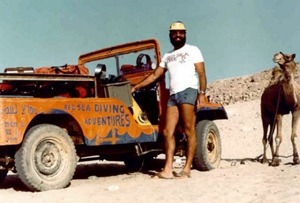
In the early 70s, the pioneer of diving in the Sinai, Howard Rosenstain, founded one of the first Israeli dive centers, Red Sea Divers, in Naama Bay. That’s just 200 m from Dolphin Diving Center location.
The success was fantastic. Many divers from all over the world and film crews from many world film studios passed through this dive center and the first liveaboards boats Fantasea 1 and Fantasea 2 that appeared later.
In 1977, Howard conceived a project that would attract interest in the Sinai sector of the Red Sea. The whole world was impressed by the just-released movie "Depth" and the story told in it about the discovery of the steamer Rhone, which sank in the British Virgin Islands on October 29, 1867. Howard began to search for a suitable sunken ship.
The Bedouin fishermen proved to be an invaluable source of information, and it was also not so difficult to follow their instructions: "In the strait (Gubal) there is one place far from the coast. To find it, go into the sunset and three cigarettes away from Ras Mohamed you will find a reef in the shape of crescent moon, which is exposed at low tide. Go to the tip of the reef from the southeast."
Beacon Rock Reef
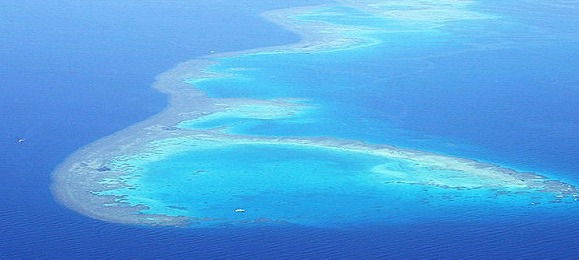
Using this and other information, Howard and his team narrowed down the search area and fortune smiled on them.
"Jumping into the water right above the wreck was a great luck. A group of Americans, led by Carl Rosseler of the Sea&Sea team, witnessed this dive," Howard wrote.
The ship they found was Dunraven. But another 2 years passed before it was possible to find out its true name and history.
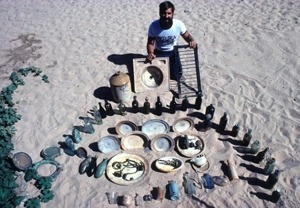
During World War I, Colonel Thomas Edward Lawrence, known to the British as Lawrence of Arabia and to the Arabs as El Laurens, used several ships to deliver money and jewelry from Suez to the Port of Aqaba. The design of some of these ships was very similar to that of Dunraven.
The story of Lawrence of Arabia became widely known after the release of the blockbuster “Lawrence of Arabia” in 1962, starring Peter O'Toole and great Egyptian actor Omar Sharif. The film received 7 Oscar nominations and became one of the highest-grossing films of that time.
Very soon, rumors began to circulate that divers had found the missing ship of El Laurens' treasure. The names of Lawrence's ships were known: Dufferin, Harding, M-31 and Suva. None of them went missing. However, Howard needed a theory about the connection between the discovered wreck and the activities of Lawrence of Arabia. And it worked: BBC expressed a desire to make a film about the sunken ship. Today, 33 years later, Rosenstein admits that he intentionally made up this connection to history. Be that as it may, he achieved his goal - he attracted the attention of many divers to his corner of the World Ocean.
Eventually, it became apparent that there was no connection between Lawrence and the wreck he had found. However, this version was replaced by another, no less attractive. During the First World War, Britain used a fleet of "Q ships". This was the name of civilian ships with covertly installed weapons. The main target of these ships were German submarines, and the main arena of their activity was the North Atlantic and the Mediterranean Sea. However, several of these ships were in the service of British intelligence and could be sent to the Middle East on a secret mission. The fate of some "Q ships" is still unknown.
Be that as it may, it was not until 1979 that the name "Dunraven" was discovered on porcelain dishes raised from the wreck. Rosenstein and his crew also cleaned the stern of the ship, where the inscription "Dunraven" was found. The operation to clean the stern of the ship was filmed by the BBC team and became an episode of the documentary film "Mysteries of the Sunken Ships of the Red Sea", which was released at the end of 1979.
The dramatic story around the sunken ship continued. At the same time that the ship's research was taking place, Arab-Israeli peace talks were underway at Camp David (USA). Dunraven failed to become part of the Arab history of the turn of the century, but, unexpectedly, it became a small episode in the modern history of the region.
Full story of Dunraven discovery. Courtesy of Howard Rosenstein himself
Upon his return from Camp David, U.S. Ambassador to Israel Samuel Lewis gave an interview to the BBC. His conversation with British correspondents was included in a documentary about the sunken ships. In this interview, the decision to return the Sinai Peninsula to Egypt was announced for the first time. As soon as Rosenstein achieved an incredible breakthrough in international media coverage of his discovery, it turned out that his life's work was in danger of collapse.
The Ship
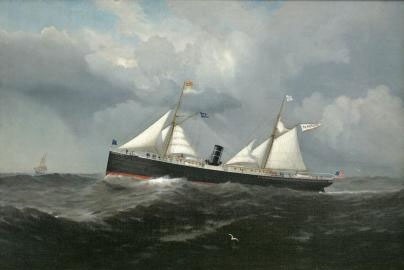
Dunraven was launched in December 1873 at the Mitchell & Co. shipyard in Newcastle, England. It was recorded in the register as an "iron screw steam vessel" and was a sailing-steam brigantine. It was a relatively new type of vessel - sailing equipment, supplemented by a steam engine. The vessel had a displacement of 1,613 tons, and was powered by a 140 hp twin-cylinder steam engine manufactured by Messrs Humphrys & Tennant of Newcastle. Dunraven reached speeds of up to 8 knots. The ship is 79.6 m long and 9.8 m wide. After successful trials, it began to be used on the Bombay - Liverpool line.
Shipwreck
In January 1876, 27-year-old Captain Edward Richards was watching his ship load in Liverpool. The cargo was common: timber and steel for India's developing heavy industry. The journey to Bombay passed without incident and at the end of March the ship received a return cargo to England. Dunraven left Bombay on 6 April 1876 with a cargo which was designated as "ordinary colonial goods destined for delivery to Liverpool". The ship's crew consisted of 25 people. The ship passed the Indian Ocean without incident. After a short stop in Aden for coal loading, it continued its journey through the Bab el-Mandeb Strait and entered the Red Sea. An entry in the ship's log dated April 24 reads: "The weather is clear and calm, the wind is weak, the sea is smooth, and the sails are not set. The ship is going at full speed at a speed of 6 knots" At one o'clock in the morning, the second mate saw a mountainous coast directly on course and mistook it for Shedwan Island. Fifty minutes later, he saw the light and decided that it was the Ashrafi Lighthouse, standing in the Gubal Strait. He later described the light as "bright and still." The captain was on the bridge all this time, and had no doubts about the correctness of the course. The helmsman showed that he had not seen the light.
At 2:15 a.m., the captain went downstairs, leaving an order to call him in an hour. At 2:40 a.m., the light was lost from sight, as if it had simply disappeared. Later, the second assistant gave unclear evidence on this matter. At first, he stated that he called the captain as soon as he lost sight of the light, but then changed his testimony, indicating that it was around 3:30-3:40.
At 3:40 a.m., the captain appeared on deck. A mountainous shore could be seen 6 or 7 miles on the starboard side in a northerly direction. The captain immediately changed course two points to the right, that is, closer to the ground. Ten minutes later, the lookout saw something large and dark in the water. Deciding that it was a buoy, he reported to the bridge, but did not receive an answer. At the same moment, the second mate also saw a dark object, but did not pay attention to it, and informed the captain only in passing. Edward Richards immediately ordered the machine to stop, but before the command was carried out, Dunraven ran into the reef, having received a hole below the waterline near the bow. The steam pumps immediately began to work, but by seven o'clock in the morning the water reached the engine room, and flooded the furnaces. By noon, the starboard side of the deck was under water and the captain and crew moved to the lifeboats. They remained near the doomed ship until four o'clock in the afternoon, when an Arab coaster took the victims on board. Only then did Captain Richards learn his true location - the southern tip of the Sinai Peninsula. At five o'clock in the evening, Dunraven slid off the reef and went under water to a depth of 27 meters. For three days, the Arabian sailing ship was anchored over Dunraven until the captain and his crew was transferred to the passing Italian steamer Arabia, which ferried them to Suez. Later, the steamer Malva of the Peninsula & Orient Company took the crew and captain to England.
Following the proceedings before the Merchant Shipping Commission, the judge stated that "that the captain made no real effort to establish the true location of the ship from noon on 24 April until her collision with the reef at 3:50 a.m. on 25 April. Neglect of this most important precaution most likely led to the loss of the ship. In addition, after a careful study of the navigational chart, it seems obvious that the land seen by the second mate could not have been the island of Shedwan, and the light could not have been the light from Ashrafi's lighthouse. The court recognized the loss of Dunraven as the result of a mistake and neglect of his duties by Captain Edward Richards and suspended his captain's license for 12 months, granting, however, the opportunity to go to sea as first officer.
Diving on Dunraven
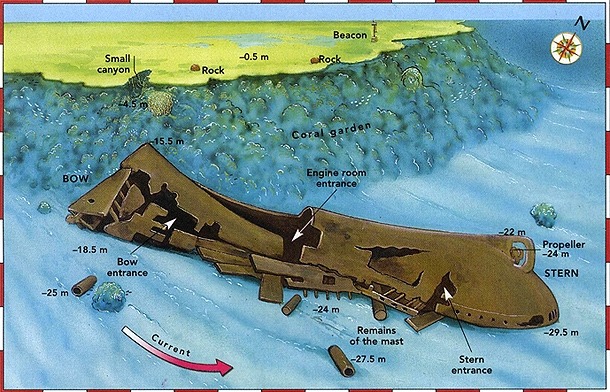
Dunraven lies keel up on a vast sandy plateau with rare corals. The bow of the ship rests on the reef at a depth of 17 meters and this depth is the minimum for this dive. The stern lies at a depth of 29 meters towards the sea.
The inspection begins with the bow of the ship, which has been destroyed by impact on the reef and corrosion. From the hawse on the port side, almost completely hidden between the vessel and the reef, the anchor chain goes. A piece of chain hangs from the hawse on the starboard side, heavily overgrown with coral. Due to severe damage to the bow of the ship, the inspection takes place for the most part from the outside. Next, you will head to the stern of the vessel along the starboard side, in some places badly damaged. Here, at the bottom, you can see the remains of two masts and the basket of the lookout ahead. Among the rare corals on the sand, you can find stingrays, moray eels, scorpionfish. A family of friendly Napoleons lives here almost permanently.
In the aft part there is a propeller - steering group. One propeller blade is broken off. From the propeller we descend vertically down to the very bottom, where the depth reaches 29 meters (the maximum depth on this dive). Here there are quite wide breaches in the hull of the vessel, allowing you to easily get inside. When getting inside, it is recommended to have an underwater torch, but you can do without it, as a lot of natural light penetrates through the portholes and breaches in the hull of the vessel. Swimming inside, you will find yourself in the large and empty interior space of the ship. Along the bottom, which has become the "ceiling", there is a propeller shaft. All copper fasteners, unfortunately, disappeared in the time of Howard Rosenstein. The greenish twilight reigning inside the ship, the light penetrating through the portholes, and the dark ribs - the frames invariably create the atmosphere of an ancient sailboat.
Moving towards the bow of the vessel, you will find yourself at the engine room, where two huge boilers serve as supports for the hull structures. The cauldrons are side-by-side and take up most of the space at this location, leaving only a narrow passage on the left, allowing divers to pass here only one at a time. On the other side of the boilers, on the port side, are all the taps, valves and the engines themselves, with the connections and pistons intact.
Stop right above the cauldrons and hold your breath for a moment. You will hear a steady rumble. Arabian guides will tell you that the steam heart of Dunraven will continue to beat. In fact, you hear the sound of large air bubbles bursting out of the holes in the hull. The huge hull of the ship creates a sound resonance that resembles the sound of a working engine.
Next, you will pass through a narrow passage on the starboard side, which leads to a huge rift in the hull of the ship. Here the internal inspection of the sunken ship ends. Before leaving, you can see a large school of glassfish, always preferring shade and parting only to let you pass and again closing in into a whole, pulsating ball. Lionfish and scorpionfish are also often seen here.
Coming out through the crack in the hull, you can turn back and, if you have enough air, swim outside along the keel and port side, densely covered with coral up to the propeller. After inspecting the wreck, you should return to the reef and drift downstream in any direction along the wall. A buoy should be launched from a depth of 5 meters. Beacon Rock Reef is known for its strong surf. Therefore, to go to the boat or zodiac, you should swiml away from the reef.
Beacon Rock is also known for frequent encounters with sharks. Including oceanic whitetip sharks. (longimanus). Therefore, we advise you to refrain from snorkeling in this place!
Epilogue
Caritan Edward Richards was born in 1849 in the port town of St. Ives, Cornwall, where a fashionable seaside resort is now located. In 1872, at the age of 23, he received a diploma of captain of the merchant marine. This is an unusually early age for the rank of captain. Prior to Dunraven, he commanded Etna and Alvega merchants. After the loss of Dunraven in 1874, it was three years before he could become a captain again. Etna was again placed under his command. All his life he remained a captain of the merchant fleet.
After the return of the Sinai to Israel, Howard Rosenstein left Ophira (as Sharm el-Sheikh was then called). But for many more years he was engaged in the exploration of the Red Sea and the Indian Ocean from the Fantasea 1 and Fantasea 2 research and safari boats. The 35-metre luxury yacht (Lloyds class 100 A1 + LMC) Fantasea 2 is still carrying divers in Indonesia. The new name of the vessel is "Pelagian". Currently, Howard Rosenstein is the owner of the company "Fantasea" http://www.fantasea.com/s.nl/it.I/id.16/.f, specializing in the production of boxes for underwater photo and video shooting and resides in Israel. In 2009 he was awarded the International Scuba Diving Hall of Fame Prize for his outstanding contribution to the development of diving and the exploration of the underwater world.

 Diving in Sharm el-Sheikh
Diving in Sharm el-Sheikh